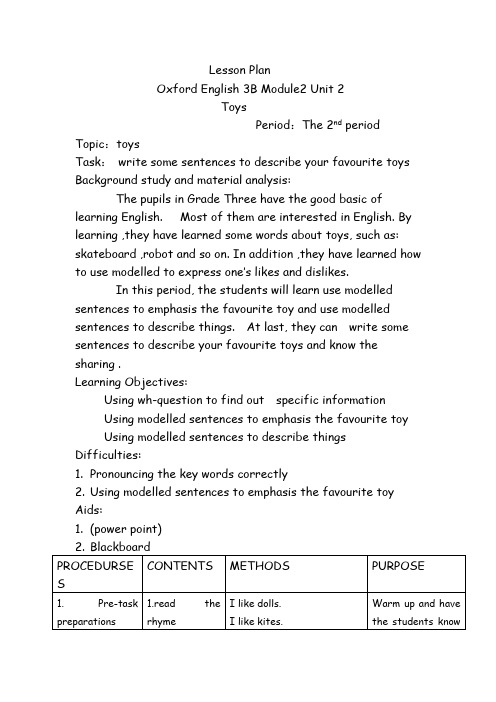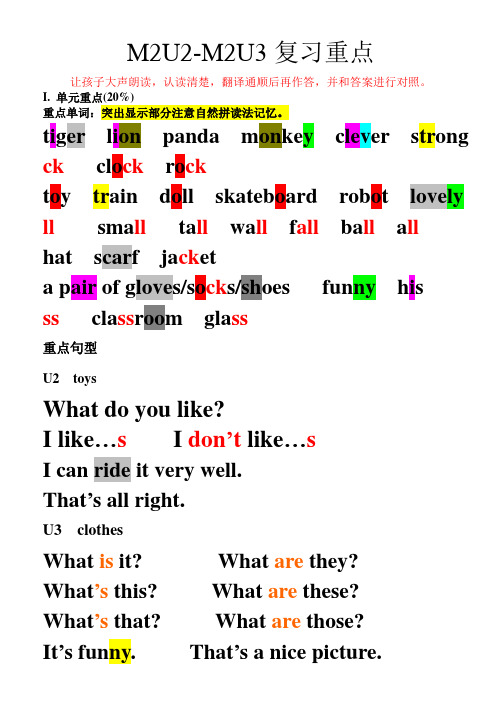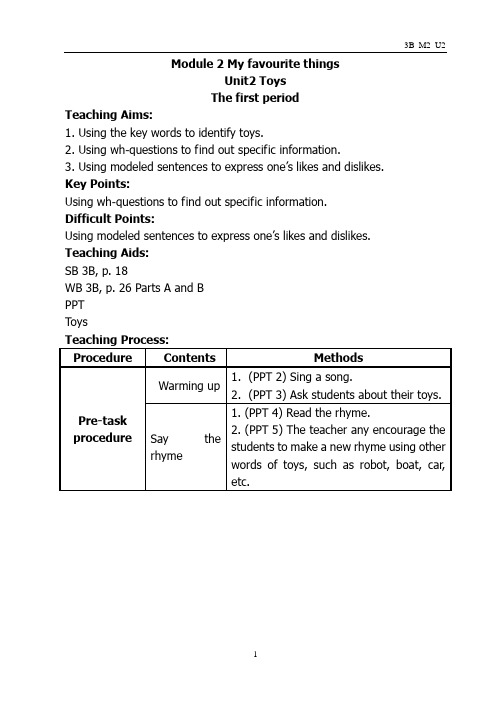3B Module 2 U2三年级英语
- 格式:docx
- 大小:17.62 KB
- 文档页数:4

Lesson PlanOxford English 3B Module2 Unit 2ToysPeriod:The 2nd period Topic:toysTask:write some sentences to describe your favourite toys Background study and material analysis:The pupils in Grade Three have the good basic of learning English. Most of them are interested in English. By learning ,they have learned some words about toys, such as: skateboard ,robot and so on. In addition ,they have learned how to use modelled to express one’s likes and dislikes.In this period, the students will learn use modelled sentences to emphasis the favourite toy and use modelled sentences to describe things. At last, they can write some sentences to describe your favourite toys and know the sharing .Learning Objectives:Using wh-question to find out specific informationUsing modelled sentences to emphasis the favourite toyUsing modelled sentences to describe things Difficulties:1.Pronouncing the key words correctlying modelled sentences to emphasis the favourite toy Aids:1.(power point)On the blackboard:I like …I don’t like ….What do you like?I like ….It’s ….Notes:Exercise paper1.Listen and fill in the blanks .Mum:What do you ____?Ben: I like______.They are ______.Kitty: I _____ _____like skateboards. I like______. They are beautiful. Mum: ____you like____,Alice?Alice: Yes, I _____. And I like bears too.____ ______nice.2. Finish the tableCommentaryThe topic of Oxford English 3B Module2 Unit 2 is about my favourite toys. In this period, the students will learn use modelled sentences to emphasis the favourite toy and use modelled sentences to describe things. At last, they can write some sentences to describe your favourite toys and know the sharing .The pupils in Grade Three have the good basic of learning English. Most of them are interested in English. By learning ,they have learned some words about toys, such as: skateboard ,robot and so on. In addition ,they have learned how to use modelled to express one’s likes and dislikes. But I think they will have the difficulties in using modelled sentences to emphasis the favourite toy .I’ll finish this lesson in following steps.1.Pre-task preparations1)I will begin my class with a rhyme “I like dolls.I like kites.’”It will help the students to warm up and have the students know the topic of this unit.2)Daily talkI will show a picture of a toy shop to tell the studentsthe scene is at the toy shop. Then I will ask some questions, such as “Do you like…”, then the students will answer yes or no.I will encourage them to answer the questions completely.3)a pair work (I like…I don’t like…)I will show many different toys ,then have the students use the modelled sentences to express one’s like and dislike.2. While-task procedures1) What do you like? I like …I will have the students to ask and guess what toys I like . Then the students will ask me “What do you like?” In order to consolidate this sentence, I have a activity. Have the students ask one by one”What do you like”.2) .What do you like?I like this ….It’s…I like skateborads . So I will show many skateboards and tell the students I like this skateboard. Ask them why I like this skateboard. Then the students will say “Maybe it is nice.”Now I review adj.After this, I will show many different toys and encourage the students make a dialogue with his deskmate.S1: What do you like?S2:I like this ….It’s…3. Post-task activities1) Activity 1 Listen and fill in the blanks .The students will have a sheet to listen and fill in the blanks .The students will write the words by themselves. Mum:What do you ____?Ben: I like______.They are ______.Kitty: I _____ _____like skateboards. I like______. They are beautiful.Mum: ____you like____,Alice?Alice: Yes, I _____. And I like bears too.____ ______nice. Then Have the students work in small groups and role-play a dialogue.2) Activity2 Finish the table3) Activity 3 A group workStep 1. Have the students draw their favourite toysStep2.Write several sentences to describe themStep3. Read the sentences in groups4) Let’s share the toysI will show some children who have different toys .And tell the students “They are sharing their toys together.So everyone has many toys.”4.Assignments.Ask your friends or parents what toys they like and help them write some sentences to describe the toysAfter learning this lesson, the students can use modelled sentences to emphasis the favourite toy and use modelled sentences to describe things.。

M2U2-M2U3复习重点让孩子大声朗读,认读清楚,翻译通顺后再作答,并和答案进行对照。
I. 单元重点(20%)重点单词:突出显示部分注意自然拼读法记忆。
tiger lion panda monkey clever strong ck clo ck ro cktoy train doll skateboard robot lovely ll sma ll ta ll wa ll f all ba ll a llhat scarf ja ck eta pair of gloves/so ck s/shoes funny hisss cla ss room gla ss重点句型U2 toysWhat do you like?I like…s I don’t like…sI can ride it very well.That’s all right.U3 clothesWhat is it? What are they?What’s this? What are these?What’s that? What are those?It’s funny. That’s a nice picture.Ⅱ. 补全单词1. t_y tr_ _n2. d_ll3. sk_t_b_ard4. r_b_t5. h_t6. sc_ _f7. j_ck_t 8. a pair of gl_ves9. a pair of s_cks 10. a pair of sh_ _s11. f_nny12. tr__sers 13. cl_thes14. _ y 15. th_y16. l_ke 17. b_xⅢ. 写出下面同类词skirt _______ ________ _______ _______ ________ kite _______ _______ _______ _______ ________ Ⅳ. 选词填空,完成句子。

《牛津小学英语》3B Unit2 Yes or no 在小学英语的学习旅程中,《牛津小学英语》3B Unit2 Yes or no 为孩子们打开了一扇有趣的语言之门。
这一单元的内容丰富多样,充满了生活中的实际情境和实用的英语表达。
让我们先来看看这一单元的词汇部分。
孩子们会接触到一系列与日常生活息息相关的单词,比如“clock”(钟)、“camera”(照相机)、“computer”(电脑)等等。
这些词汇不仅是日常生活中常见的物品,也是构建英语语言基础的重要基石。
通过学习这些词汇,孩子们能够更加准确地描述周围的事物,增强他们的语言表达能力。
在句型方面,“Is this a? Yes, it is /No, it isn't”这一句型是本单元的重点。
这一句型简单实用,可以让孩子们学会用英语来询问和确认物品的属性。
例如,当他们看到一个不熟悉的东西时,可以用“Is this a pen?”来询问,然后根据回答“Yes, it is”或“No, it isn't”来获取信息。
这种互动式的学习方式,能够激发孩子们的好奇心和探索欲,让他们在实际运用中逐渐掌握英语的表达方式。
为了帮助孩子们更好地理解和掌握这些知识,教材中还配备了生动有趣的图片和情境对话。
比如,有一幅图片展示了一个房间,里面摆放着各种物品,孩子们需要通过观察和思考,用所学的句型来猜测和确认物品的名称。
这样的设计不仅增加了学习的趣味性,还培养了孩子们的观察能力和逻辑思维能力。
在教学过程中,老师们可以采用多种教学方法来提高孩子们的学习效果。
比如,通过游戏的方式让孩子们在轻松愉快的氛围中学习单词和句型。
比如“猜物品”的游戏,老师将一个物品藏在背后,让孩子们用“Is this a?”来猜测,然后老师根据实际情况回答“Yes, it is”或“No, it isn't”这种游戏不仅能够让孩子们快速记住单词和句型,还能够增强他们的自信心和参与度。

2019-2020年三年级英语下册 3B Module2 Unit2教案沪教牛津版知识目标:1、New words: these,bicycle, doll, bear, super, beautifu2、Sentences: These bicycles, are supper, I like this bicyck能力目标:1、能正确使用these, this两个指示代词。
2、能结合本课句型进行介绍或对话。
情感目标:教育学生爱护自己的玩具。
Important poimt:1、正确朗读本课单词,进一步了解名词复数的运用。
2、this, these两个指示代词的意义及用法。
Different poinits:1、区别this, these的意义及后跟的名词单复数。
2、正确表达本课句型,能灵活进行对话。
一、pre-task preparation1.Show the toys to the. students and introduce:Bicycle, cloths , bears2.Put the pictures of toys and word cards on the blackboard. Encourage students toread them.二、While-task procedure.1、Show them a pencil and say:This pencil is long.Show them some pencils and say:These pencils are long.2.Encourage students to say:This bicycle/doll/bear isThese bicycles /dolls/bears are3.教师根据学生所说出的句子及时间:Do you like this ?Do you like these ?Encourage studewts to say:Yes, l like this / No, I don’t likeYes, I like these / No, I don’t like these4.Ask and answer in pairs:Do you like ?Yes, I like /No , I don’t like5.Show them some super bicycles and say:This bicycle is super.These bicycles are superT: ’super’ is means very mice.‘ Beautiful ’ is means very nice.6.Encourage students to make sentences with “super”, ”beautiful”,7.Play the cassette, students listen and follow in their books then repeat.8.老师指着黑板上的图片说:I like this doll. I don’t like tears.Ask students to speak like this.9.利用活页资料让学生向一组学生了解他们最喜爱的玩具。

Module 2 My favourite thingsUnit2 ToysThe first periodTeaching Aims:1. Using the key words to identify toys.2. Using wh-questions to find out specific information.3. Using modeled sentences to express one’s likes and dislikes. Key Points:Using wh-questions to find out specific information.Difficult Points:Using modeled sentences to express one’s likes and dislikes. Teaching Aids:SB 3B, p. 18WB 3B, p. 26 Parts A and BPPTToysModule 2 My favourite thingsUnit 2 ToysThe second periodTeaching Aims:1. Using wh-questions to find out specific information.2. Using modeled sentences to express one’s likes and dislikes.3. Using yes/no questions t elicit a positive or negative response.4. Using the key words and sentences to identify different toys and talk about them.Key Points:1. Using wh-questions to find out specific information.2. Using modeled sentences to express one’s likes and dislikes.3. Using yes/no questions t elicit a positive or negative response. Difficult Points:1. Using modeled sentences to express one’s likes and dislikes.2. Using modeled sentences to describe things.Teaching Aids:SB 3B, p. 19, 21WB 3B, p. 27 Parts C and DPPTToysModule 2 My favourite thingsUnit 2 ToysThe third periodTeaching Aims:1. Using wh-questions to find out specific information.2. Using modeled sentences to express one’s likes and dislikes.3. Using modeled sentences to describe things.4. Using formulaic expressions to express apology or show concern for others.5. Pronouncing the sound ‘-ll’ correctly in words such as small, tall and wall. Key Points:1. Using modeled sentences to express one’s likes and dislikes.2. Pronouncing the sound ‘-ll’ correctly in words such as small, tall and wall. Difficult Points:1. Using modeled sentences to express one’s likes and dislikes.2. Using modeled sentences to describe things.Teaching Aids:SB 3B, pp. 20, 21WB 3B, p. 30 TaskPPT。

Module 2 My favourite thingsUnit2 Toys I likeThe First Teaching Plan知识目标:1、New words: these,bicycle, doll, bear, super, beautifu2、Sentences: These bicycles, are supper, I like this bicyck能力目标:1、能正确使用these, this两个指示代词。
2、能结合本课句型进行介绍或对话。
情感目标:教育学生爱护自己的玩具。
Important poimt:1、正确朗读本课单词,进一步了解名词复数的运用。
2、this, these两个指示代词的意义及用法。
Different poinits:1、区别this, these的意义及后跟的名词单复数。
2、正确表达本课句型,能灵活进行对话。
一、pre-task preparation1.Show the toys to the. students and introduce:Bicycle, cloths , bears2.Put the pictures of toys and word cards on the blackboard. Encourage students toread them.二、While-task procedure.1、Show them a pencil and say:This pencil is long.Show them some pencils and say:These pencils are long.2.Encourage students to say:This bicycle/doll/bear isThese bicycles /dolls/bears are3.教师根据学生所说出的句子及时间:Do you like this ?Do you like these ?Encourage studewts to say:Yes, l like this / No, I don’t likeYes, I like these / No, I don’t like these4.Ask and answer in pairs:Do you like ?Yes, I like /No , I don’t like5.Show them some super bicycles and say:This bicycle is super.These bicycles are superT: ’super’ is means very mice.‘ Beautiful ’ is means very nice.6.Encourage students to make sentences with “super”, ”beautiful”,7.Play the cassette, students listen and follow in their books then repeat.8.老师指着黑板上的图片说:I like this doll. I don’t like tears.Ask students to speak like this.9.利用活页资料让学生向一组学生了解他们最喜爱的玩具。
LESSON PLANOxford English 3B Module 2 Unit 2ToysTopic: My favourite toysPeriod: 3rd periodTask: Talk about your favourite toy by using the words and new phrases (e.g. play basketball, ride the skateboard, hold the doll, ect.) and talk about the reason why this toy is your favourite toy by using the key pattern (e.g. My favourite toy is … Because I can / it can …)Background study and material analyses:本班三年级的学生在两年级的时候已经学习过ball, doll等一些表示玩具的单词。
在本Module的第一单元学习过I like …的句型。
但是,对于为什么喜欢,学生很想表达,却苦于不知如何说起。
因此,本课中教师向学生提供了类似文本,再让学生从文本中找出别人为什么喜欢这些玩具,再让学生利用学过的句型和词组构成自己的文本:My favourite toy。
Learning Objectives:1. Try to review the words: skateboard, ball, doll, robot, toy train2. Try to read and use the phrases: play basketball, ride the skateboard, hold the doll, go all around the room3. Try to talk about the favourite toys and the reason why this toy is your favourite. Know the toys accompanied with you when you grow up. Difficulties:1. Reading the new phrases correctly.2. Using key phrases and patterns to make an interaction.Aids:1. Multi-media2. Word cards3. WorksheetOn the board:M2U2 ToysMy favourite toystoy train go all around the room interesting doll hold my doll lovely robot walk super skateboard ride the skateboard funball play basketball fun附:本课文本The favourite toysHello, I’m Shirley. My brother, sister and friends have many toys. We all have one that is our favourite toy.My brother Ben’s favourite toy is his skateboard. It’s black. It’s smooth. He can ride it very well. Look! It’s fun.My sister Kitty’s favourite toy is her doll. It has short hair. It has two small eyes. She likes holding her baby doll. It’s lovely.My friend Mike’s favourite toy is his ball. It’s rough and soft. He can play basketball very well. It’s fun.My friend Danny’s favourite toy is his robot. It’s smooth. It can walk. It’s super.My favourite toy is my toy train. It’s long. It’s smooth. It can go all around the room. It’s interesting.We like toys. We need toys. They’re our friends.。
Module 3 PlaygroundUnit 2 I don’t like riding bikes.教学目标:1.激发学生学习的兴趣。
2.学习表达自己的喜好。
3.学习三个字母。
4.培养学生听、说、演等智能以及培养学生运用语言的能力。
教学重点:1.学习运用语言结构:Ilike swimming. I don't like skipping.2.学习字母Dd, Ee, Ff。
教学难点:Like 后加动名词的用法。
教具准备:录音机、磁带、各种球、各种运动图片。
教学过程:I、Warming up:放录音,学生跟录音一同唱Old MacDonald has a zoo.歌。
II、Revision:1.教师将一些球放在讲桌上,(如果是图片则贴到黑板上)教师请两名学生一同到前面来。
两人分别选择两样球举起来(或分别指向两张图片),并分别说明“I like….”, “I don’t like….”2.教师可以多叫几名同学来做这样的活动。
III、Presentation:1. 学习各种运动词汇教师分别出示运动图片,并领读,同时呈现单词或词组的拼写。
教师请学生两人一组练习运动词汇。
教师请学生将运动图片贴到黑板上,再找学生在每一个运动图片下贴出相应的词汇拼写。
教师带领学生做游戏,一人做动作,其他同学猜出是哪一种运动。
2. 运用I like… I don’t like…来表达喜好。
教师先做示范。
教师走到黑板处,分别指着上面所贴的运动图片来说明自己喜欢的运动以及不喜欢的运动。
教师请学生到前面来指着各种运动图片来说明他们都喜欢什么运动以及不喜欢什么运动。
3.完成课本中的活动1。
教师请学生听录音,看看图中的人物有什么样的喜好。
学生跟录音读一遍课文。
4.学习chant放录音,请学生先听两到三遍,让学生对节奏韵律有个初步的印象,并通过看书,听录音找到自己还不会的单词。
请学生自己读出chant。
请学生根据自己的喜好来编一段chant.5.我喜欢的可爱的小动物教师请学生读出活动5中的对话。
Module 2 My favourite thingsUnit 2 ToysI. Translation(翻译):1. 这个机器人2.那个滑板3. 一辆玩具火车4.一个可爱的娃娃5. 跳进盒子6.在大树下7. 一辆小自行车8.一只玩具熊II. Write with “is, am,are, do, does, don’t”(用“is, am, are,do, does, don’t”填空):1. How the apple feel? It hard.2. I at school. My mother at home.3. you like tigers? No, I .4. My name Ron. I a robot.5. Look! The big monkeys in the tree. That little monkey under the tree.III. Answer the questions(回答问题)1.What do you like?(滑板)2.Do you like this doll?(是的)3.What can you see?(两个机器人)4.How does the toy car feel?(又硬又光滑)5.How much is this toy car?(十元)IV. Reading(阅读理解,用“T”或“F”表示):Hello, my name is Tommy. I’m nine years old. I’m a pupil of Park Schoool. I have many toys in the big box. I have a skateboard and an aeroplane. I have three toy cars too. One is black, one is blue and one is red. I like my cars and I like the red one best. It is hard and smooth. It can run fast.( ) 1. Tommy is nine years old.( ) 2. Tommy has many toys.( ) 3. Tommy’s cars are black, white and red.( ) 4. Tommy likes the blue car best.( ) 5. The red car is smooth.I. Copy the sentences(抄写句子,注意大小写及标点符号):what do you like doing peter i like singingII. Choose the best answer(选择最恰当的答案):( ) 1. What do you like? I like .A. flowerB. a flowerC. flowers( ) 2. Look the butterflies. They are beautiful.A. atB. toC. /( ) 3. I like monkeys. But I like tigers.A. doB. don’tC. doesn’t( ) 4. These bicycles super.A. amB. isC. are( ) 5. I can see a in the sky.A. dollB. carC. bird( ) 6. Smell the flowers. Are they ? Yes, they are.A. niceB. softC. red( ) 7. is the football? It’s black and white.A. HowB. WhatC. What colourIII. Read and write(按要求改变句子):1.This bag is small.(否定句,意思不变)This bag .2.The elephants like bananas.(划线提问)the elephants like?3.I like the puple grapes.(否定句)I the puple grapes.4. The boys like to play football.(一般疑问句)the boys to play football?5. My robot is hard and smooth?(划线提问)your robot feel?6. We like ice-creams.(划线提问)you like?Unit 2 单元练习I. Copy the sentences(正确抄写下列句子,注意大小写及标点符号):what do you like alice i like toy rabbits___________________________________________________________ Ⅱ. Read and write(按要求写单词):1.toy(复数)_________2.box(复数)_________3.nice(同义词)________4.monkey(复数)___________5.do not(缩写形式)_________6. robot(同类词)_________7.that (反义词) _________ 8.isn’t(完整形式)_________III. Read and write (填入所缺的词,使句子通顺,每格一词):1. What colour is the ________? It’s ________.2. I ________ the doll, but I ________ like the robot.3. Do you like _______ ? No, I _________ .4. Look at the ________. It is ________.5. What’s that? It’s an ________.IV. Read and choose (读一读,选择最恰当的答案):( ) 1. My little brother _______ a new bicycle.A.haveB. hasC. is( ) 2. Do you like riding skateboards? Yes, I ______.A. likeB. doC. don’t( ) 3. ________ is toy tiger? It’s black and orange.A. HowB. WhatC. What colour( ) 4. What’s that in the tree? It’s __________ .A. kiteB. a kiteC. bird( ) 5. What do you like doing? I like _________ .A.playing basketballB. play basketballC. to playing basketball ( ) 6. How many robots do you have? ________ three.A. There areB. They areC. I have( ) 7. I’m hungry. I want some ________ .A. breadB. breadsC. hamburgerV. Translation(翻译):1.一些盒子2.很多锡纸3. 这个娃娃4.那些滑板5. 做一个机器人6.一架飞机7. 一些胶水8.粘贴纽扣VI. Choose the best answer(选择最恰当的答案):( ) 1. What are these over there? _________ are balloons.A. TheseB. ThisC. They( ) 2. the apple. It’s hard.A. SmellB. TasteC. Touch( ) 3. I can write with my .A. eyesB. handsC. nose( ) 4. Touch the desk. It’s not .A. hardB. softC. smoothVII. Read and write(用所给单词的适当形式填空):1. How (do) the coffee taste? It’s bitter.2. What (do) you like? I like (panda).3. Taste the (peach). They (be) sweet.4. How many (box)? One (box).5. I have some (toy). I like this (toy) best.6. How does the (salt) taste? It is (salt).VIII. Reading(阅读理解,回答问题):There is a red kite in the tree. It’s Tom’s kite. Tom can’t climb the tree. He’s sad. Miss Fang can help him. She can climb the tree. Now the kite is in Tom’s hand. He’s happy. Miss Fang is happy too. Look! She is flying the kite with Tom now.1.Where is the kite?2.Is this Tom’s kite?3.What colour is the kite?4.Can Tom climb the tree?5.Is Tom happy now?。